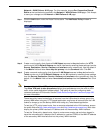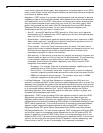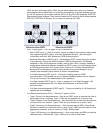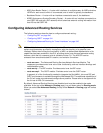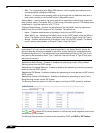
Network > Routing
338
SonicOS 5.8.1 Administrator Guide
–
Type 5 (AS External Link Advertisements) – Sent by ASBR (Autonomous System
Boundary Routers) to describe routes to networks in a different AS. Type 5 LSA’s are
net sent to Stub Areas. There are two types of External Link Advertisements:
• External Type 1 - Type 1 packets add the internal link cost to the external link cost
when calculating a link’s metric. A Type 1 route is always preferred over a Type 2
route to the same destination.
• External Type 2 - Type 2 packets only use the external link cost to determine the
metric. Type 2 is generally used when there is only one path to an external AS.
–
Type 6 (Multicast OSPF) - Spooky. See RFC1584.
–
Type 7 (NSSA AS External Link Advertisements) – Sent by ASBR’s that are part of an
NSSA (see ‘Stub Area’).
• Stub Area – A stub area is an area that only requires one path, rather than an optimal path.
This can be an area with only a single point of egress, or it can be an area where SPF
optimization is not necessary. All routers in a stub area must be configured as stub routers,
and rather than receiving the full state database, and computing the SPF tree, they will
receive only a summary link information. There are different type of stub area:
• Stub area – The standard stub area receives all LSA’s except for LSA type 5 (AS External
Link advertisement). This helps to keep the LSDB smaller, and reduces the computational
overhead on the router.
• Totally Stubby Area – A special type of stub area into which LSA types 3 (Summary Links),
4 (AS Summary Links) and 5 are not passed. Only intra-area routes, and a default route are
advertised into totally stubby areas.
• NSSA (Not So Stubby Area) – Described by RFC3101, NSSA is a hybrid stub area that
allows external routes to be flooded within the NSSA area using type 7 LSA’s (NSSA AS
External Routes), but does not accept type 5 LSA’s from other areas. NSSA’s are useful
when connecting a remote site running a different IGP (such as RIP) to an OSPF site,
where the remote site’s routes do not need to be distributed back to the main OSPF site.
An NSSA ABR (Area Border Router) also has the ability to translate type 7 to type 5 LSA’s
(this is possible only from the SonicOS Enhanced CLI).
• Router Types – OSPF recognizes 4 types of routers, based on their roles:
• IR (Internal Router) - A router whose interfaces are all contained within the same area. An
internal router’s LSDB only contains information about its own area.




